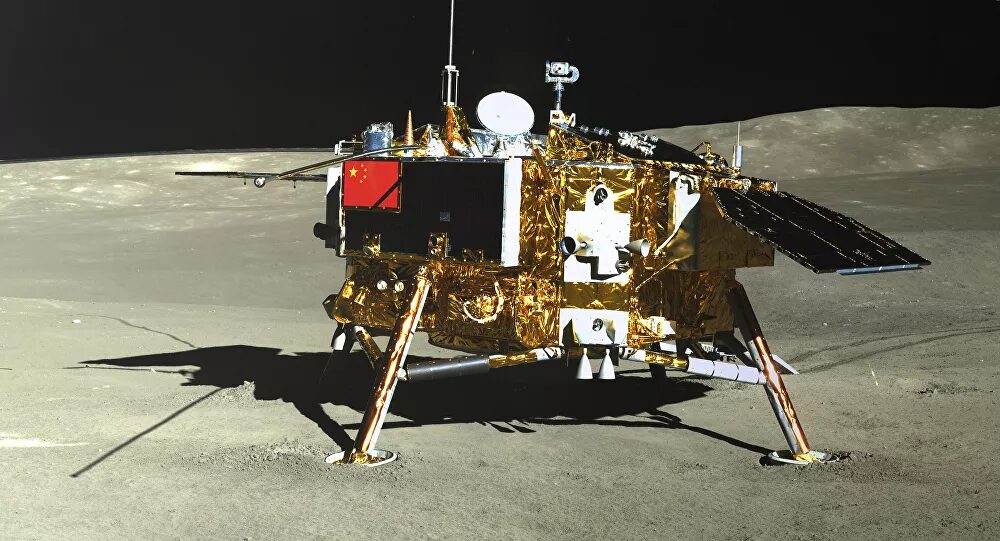
© AP Photo / China National Space Administration/Xinhua News Agency
Chinese scientists have published an analysis of
a curious substance on the moon which generated widespread interest following its discovery by the
Yutu 2 rover last year.
The discovery was made by a Yutu 2 drive team member in July 2019, during lunar day 8 of the rover's mission, which is part of China's Chang'e 4 mission to explore the far side of the moon. A report by Our Space, a Chinese-language science-outreach publication, revealed the discovery on Aug. 17 and described the substance using the term "胶状物" ("jiao zhuang wu"), which can be translated as "gel-like."This description, along with the initial absence of images,
sparked wide interest as well as speculation among lunar scientists.
However the substance is, as expected by scientists, made up of rock.
In their article in "Earth and Planetary Science Letters", Gou Sheng and colleagues analyzed data from
Yutu 2's panoramic and hazard avoidance cameras, and the rover's Visible and Near-Infrared Spectrometer (VNIS) instrument.
They used a procedure called spectral unmixing to break down the measured spectra from VNIS to determine the likely composition and abundance of the material.
The authors describe the material as a dark greenish and glistening impact melt breccia, measuring 20 inches by 6 inches (52 by 16 centimeters). These features are signs of possible presence of glasses, which are usually sourced from impact melts or from volcanic eruptions.According to the paper, the breccia — broken fragment of minerals cemented together — was formed by impact-generated welding, cementing and agglutinating of lunar regolith and breccia.The material, they say, resembles lunar impact melt breccia samples returned by NASA's
Apollo missions. In particular, similarities with the Apollo samples designated
15466 and 70019 are noted, a
comparison made earlier by lunar scientist Clive Neal at the University of Notre Dame.
Sample 70019, collected by astronaut and trained geologist
Harrison "Jack" Schmitt, is made of dark, broken fragments of minerals cemented together and black, shiny glass.
The results are not definitive, however. The paper notes that the analysis is limited by the fact that VNIS measurements were taken under bad illumination conditions and other factors.
Dan Moriarty, NASA postdoctoral program fellow at the Goddard Space Flight Center in Greenbelt, Maryland, said that because Chang'e 4 is exploring a completely unexplored area of the moon, spectral unmixing is especially challenging. "We don't have samples from this region that would help inform the model parameters. For this reason, the precise regolith composition results presented in this paper may not be completely accurate," Moriarty said. "However, the authors do an excellent job of rigorously documenting their approach and assumptions, so their results can be understood in the context of this extremely challenging problem."Moriarty said their interpretation of the substance seems reasonable, and is in agreement with previous interpretations based on earlier images. "It is very inspiring that contemporary missions are discovering features on the farside of the moon that resemble features observed by the Apollo astronauts," Moriarty said.
The paper also looks at the surrounding area. The measurements lead the authors to suggest the lunar regolith consists of a mixture from multiple sources. Ejecta from the impact that created the nearby Finsen crater is considered the primary source, with possible contributions from Alder crater.The
Chang'e 4 spacecraft made its historic landing in the 110-mile-wide (180 kilometers) Von Kármán Crater on the far side of the moon in January 2019.
Yutu 2 is currently getting ready for its 20th lunar day, which begins around July 14. (One lunar day is about two Earth weeks long, as is a lunar night.) During lunar day 19, which
began on June 14, the rover had driven a total of 51 feet (15.58 meters) across the lunar surface. In total, the rover has traversed about 1,520 feet (463.26 m).
The rover spent its 19th lunar morning investigating a small crater containing reflective material which could be another impact melt glass sample before continuing northwestYutu 2 and the
Chang'e 4 lander powered down on June 27 (
Chinese), bringing an end to lunar day 19.
Reader Comments
Let's call it "micro nova", and assume it is correlated with the periodical passing of the solar system through the galactic current sheet...
This is just as bad as the USA , NASA Nazis fake landing. But what can you expect when HolyWood is owned by the Chines.
Bring two rods 🤣😂
Should read
was formed by discharge generated welding, cementing and agglutinating of lunar regolith and breccia.